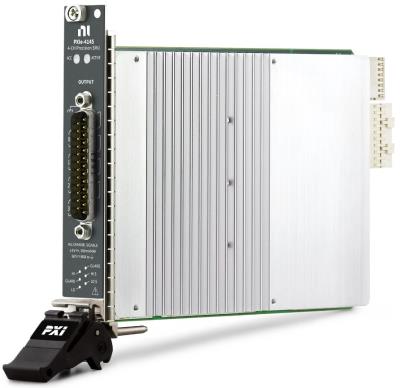
|
|
The National Instruments PXIe-4145 is a 4-channel source measure unit (SMU) ideal for high-pin-count applications. It features 4-quadrant operation and each channel has integrated remote (4-wire) sensing for accurate measurements. The fast sample rate of the PXIe-4145 can reduce measurement times, capture transient device characteristics, and allow quick I V characterization of devices under test (DUTs). With a high-speed sequencing engine, you can synchronize all these SMUs with each other or with other instruments such as switches or high-speed digital test modules. Additionally, you can tune the PXIe-4145 response to any load to achieve optimum responses with maximum stability and minimum transients using SourceAdapt technology.
Specifications.
Settling time: <100 μs to settle to 0.1% of voltage step, device configured for fast transient response, typical.
Transient response: <100 μs to recover within ±20 mV after a load current change from 10% to 90% of range, device configured for fast transient response, typical.
Wideband source noise: 1.5 mV RMS, typical, <20 mVpk-pk, typical.
Cable guard output impedance: 10 kΩ, typical.
Voltage Programming and Measurement Accuracy/Resolution.
Range | Resolution and noise (0.1 Hz to 10 Hz) | 1 Year Accuracy (23 °C ± 5 °C) ± (% of voltage + offset) | Tempco ± (% of voltage + offset)/°C, 0 °C to 55 °C.
6 V | 6 μV | 0.015% + 600 μV (Tcal ± 5 °C) |0.0005% + 1 μV.
Current Programming and Measurement Accuracy/Resolution.
Range | Resolution and noise (0.1 Hz to 10 Hz) | 1 Year Accuracy (23 °C ± 5 °C) ± (% of current + offset) | Tempco ± (% of current + offset)/°C, 0 °C to 55 °C.
10 μA |15 pA |0.03% + 3 nA (Tcal ± 5 °C) | 0.002% + 20 pA,
100 μA | 100 pA | 0.03% + 25 nA (Tcal ± 5 °C) | 0.002% + 200 pA,
1 mA | 1 nA | 0.03% + 250 nA (Tcal ± 5 °C) | 0.002% + 2.0 nA,
10 mA | 10 nA | 0.03% + 2.5 μA (Tcal ± 5 °C) | 0.002% + 20 nA,
100 mA | 100 nA | 0.03% + 25 μA (Tcal ± 5 °C) | 0.002% + 200 nA,
500 mA | 500 nA | 0.1% + 125 μA (Tcal ± 5 °C) | 0.008% + 1 μA.
Output Resistance Programming Accuracy/Resolution, Typical.
Current limit range | Programmable resistance range |Resolution | Accuracy ± (% of resistance setting), Tcal ± 5 °C.
10 μA | ± 50 kΩ | 1.0 Ω | 0.04% + 260 mΩ,
100 μA | ± 5 kΩ | 100 mΩ | 0.04% + 35 mΩ,
1 mA | ± 500 Ω | 10 mΩ | 0.04% + 13 mΩ,
10 mA | ± 50 Ω | 1.0 mΩ | 0.04% + 10 mΩ,
100 mA | ± 5 Ω | 100 μΩ | 0.04% + 10 mΩ,
500 mA | ± 1 Ω | 20 μΩ | 0.12% + 10 mΩ.
|